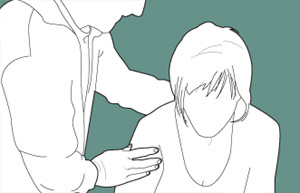Panic disorder
| Panic disorder | |
|---|---|
 |
|
| Someone experiencing a panic attack, being reassured by another person. | |
| Classification and external resources | |
| Specialty | Psychiatry |
| ICD-10 | F41.0 |
| ICD-9-CM | 300.01, 300.21 |
| OMIM | 167870 |
| DiseasesDB | 30913 |
| MedlinePlus | 000924 |
| eMedicine | article/287913 |
| Patient UK | Panic disorder |
| MeSH | D016584 |
Panic disorder is an anxiety disorder characterized by recurrent unexpected panic attacks. Panic attacks are sudden periods of intense fear that may include palpitations, sweating, shaking, shortness of breath, numbness, or a feeling that something really bad is going to happen. The maximum degree of symptoms occurs within minutes. There may be ongoing worries about having further attacks and avoidance of places where attacks have occurred in the past.
The cause of panic disorder is unknown. Panic disorder often runs in families. Risk factors include smoking, psychological stress, and a history of child abuse. Diagnosis involves ruling out other potential causes including other mental disorders, medical conditions such as heart disease or hyperthyroidism, and drug use. Screening for the condition may be done using a questionnaire.
Panic disorder is usually treated with counselling and medications. The type of counselling used is typically cognitive behavioral therapy (CBT) which is effective in more than half of people. Medications used include antidepressants and occasionally benzodiazepines or beta blockers. Following stopping treatment up to 30% of people have a recurrence.
Panic disorder affects about 2.5% of people at some point in their life. It usually begins during adolescence or early adulthood but any age can be affected. It is less common in children and older people. Women are more often affected than men.
Panic disorder sufferers usually have a series of intense episodes of extreme anxiety during panic attacks. These attacks typically last about ten minutes, and can be as short-lived as 1–5 minutes, but can last twenty minutes to more than an hour, or until helpful intervention is made. Panic attacks can wax and wane for a period of hours (panic attacks rolling into one another), and the intensity and specific symptoms of panic may vary over the duration.
...
Wikipedia
